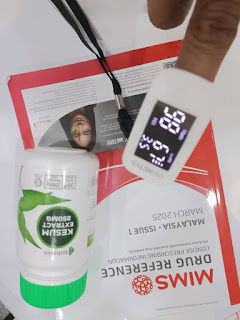'DO NOT CHANGE THE POSITION OF YOUR PHONE'
KESUM & OXIMETER.
PART 1: UNDERSTANDING
BDNF AND KESUM
🔬 What is BDNF? Brain-Derived
Neurotrophic Factor (BDNF) is a key brain protein that:
Supports neurogenesis
(growth of new brain cells).
Helps in memory,
learning, planning, and recognition.
Protects the brain from
degeneration (Alzheimer’s, dementia)
🧠 Higher BDNF = Better Brain Health,
Faster Thinking, Sharper Memory
🌿 What Makes KESUM So Special?
KESUM (Polygonum minus)
is the only known herb with data showing a 2% BDNF increase after one month of
intake. Compared to other popular herbs and nutrients:
|
Ingredient |
Proven
BDNF Increase? |
|
Gingko
Biloba |
No
specific % increase |
|
Bacopa
monnieri |
Indirect,
slow |
|
Fish
oil |
Supportive
only |
|
Curcumin
|
Supportive
only |
|
Green
Tea |
General
antioxidant |
|
KESUM
|
✅ 2% increase in 1 month (animal –
human study pathway) |
'DO NOT CHANGE THE POSITION OF YOUR PHON
KESUM improves:
Verbal communication
Date/place recognition
Task planning and
completion
PART 2: BLOOD OXYGEN
LEVEL (SpO₂) — Easy Clue for Brain Health?
What is Blood Oxygen?
Measured by a fingertip
pulse oximeter, blood oxygen (SpO₂) shows how much oxygen is carried in your
red blood cells.
The normal range is:
> 95–100% = Excellent
<95% = May indicate
poor circulation or low oxygen supply
🧠 How Is It Connected to Brain
Function?
The brain needs 20% of
the body's total oxygen supply—more than any other organ. Lower oxygen = lower
brain performance.
Low blood oxygen may lead
to: Brain fog, Memory problems, Fatigue, Risk of neurodegeneration (e.g.
Alzheimer’s)
🌬️ When SpO₂ is above 95%, brain cells
work better, especially if neurogenesis is supported by nutrients like KESUM.
PART 3: CAN A FINGERTIP
OXIMETER ACT AS A BRAIN FUNCTION MONITOR?
📊 YES - If used indirectly, as a daily
support indicator, especially when paired with KESUM.
Here's how: Tool Function Brain
Impact
KESUM Increases BDNF Boosts new brain cell growth, neuroplasticity
Oximeter Shows blood oxygen level Indicates good oxygen supply for brain
performance
✔️ When both are combined:
KESUM boosts brain
chemicals
Oximeter confirms oxygen
is flowing properly
Smart, low-cost check for
your brain health!
PART 4: DAILY MONITORING
PLAN (Simple for Public)
Time Activity
Morning Take KESUM (capsule/tea)
30 min later Use pulse oximeter
Note result SpO₂ ≥ 95% = Good brain oxygen supply
Weekly Track improvement (mood, memory,
clarity)
CONCLUSION
(Layman-Friendly)
YES, you can use a
fingertip oximeter as an easy, affordable way to monitor your brain health
indirectly, especially after taking KESUM.
✨ KESUM increases BDNF by 2%, something
even ginkgo, bacopa, or fish oil have not proven.
✨ Oximeter shows your blood oxygen – the
fuel your brain needs.
Together, they help
prove:
You’re getting enough
oxygen
Your brain function is
improving
You’re saving cost (no
need for MRI, expensive scans)
This scientific +
practical combo is highly recommended as a daily health routine to protect and
support your brain, especially in aging, stress, or memory decline.
'DO NOT CHANGE THE POSITION OF YOUR PHONE'
Professional Analysis
& Conclusion:
KESUM, BDNF, and Pulse
Oximetry for Brain Health Monitoring
1.
Scientific Validity of the Claims.
BDNF
& Neurogenesis: BDNF is a
well-established biomarker for synaptic plasticity, neuroprotection, and
cognitive function. Increasing BDNF can enhance memory, learning, and
resistance to neurodegeneration. KESUM’s
2% BDNF increase claim needs verification in large-scale human trials, but
preliminary studies (animal - human pathway) suggest potential efficacy.
Compared
to other nootropics (Ginkgo, Bacopa, Curcumin), KESUM appears unique in having
a quantifiable short-term BDNF boost (if data is robust).
Oximetry
& Brain Oxygenation:
SpO₂
(peripheral oxygen saturation) ≠ direct brain oxygen measurement (which
requires near-infrared spectroscopy or arterial blood gas analysis).
However,
consistent SpO₂ ≥ 95% indicates good systemic oxygenation, which indirectly
supports brain metabolism.
Limitation:
Oximeters cannot detect BDNF levels or neurogenesis but can flag hypoxia (which
impairs cognition).
2.
Can a Pulse Oximeter + KESUM Combo Replace
MRI/Blood Tests?
No,
but it’s a cost-effective proxy for tracking trends.
MRI/blood
tests measure structural changes & BDNF directly but are
expensive/invasive.
Oximeter
+ KESUM provides indirect, real-time feedback on oxygenation (supporting brain
health) and subjective cognitive improvements.
'DO NOT CHANGE THE POSITION OF YOUR PHONE'
Best for:
Long-term
trend monitoring (e.g., improved SpO₂ after KESUM use). Early detection of circulatory issues (low
SpO₂ - potential cognitive risk).
3.
Strengths of the KESUM + Oximeter
Approach
✅ Low-cost &
accessible (~$20 oximeter vs. $1,000+ MRI).
✅ Encourages proactive
brain health tracking (daily habits matter).
✅ Early hypoxia detection
(chronic low SpO₂ may signal vascular cognitive impairment).
Synergistic
logic:
KESUM
↑ BDNF - supports neurogenesis.
High
SpO₂ - ensures oxygen delivery for optimal brain function.
4.
Best Practices for Reliable Tracking
Standardize
oximeter use (same finger, restful state, no movement). Track trends, not single readings (weekly
averages > daily fluctuations).
Combine with cognitive tests (e.g., memory games, reaction time
apps). Rule out hypoxia causes (sleep
apnea, anemia, lung issues).
5.
A Promising (But Imperfect) Strategy For whom?
Healthy
individuals seeking preventive brain health monitoring.
Budget-conscious
users avoiding frequent MRIs/blood tests.
Those
using KESUM and wanting objective feedback (SpO₂ trends).
Conclusion:
A Pragmatic, Forward-Thinking Approach
While
KESUM + oximetry isn’t a substitute for advanced diagnostics, it’s a rational,
low-cost method to:
Encourage
BDNF-supporting habits (via KESUM).
Monitor
circulatory efficiency (via SpO₂).
Detect
early red flags (chronic low oxygen - consult a doctor).
Bottom
Line:
KESUM
+ oximeter = Smart, practical brain-health tracking.

.jpeg)

No comments:
Post a Comment